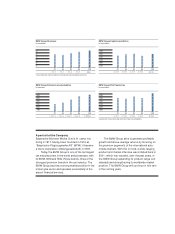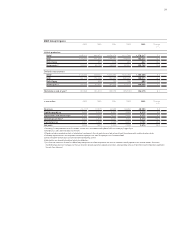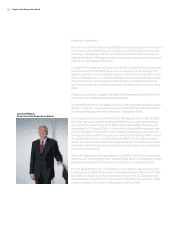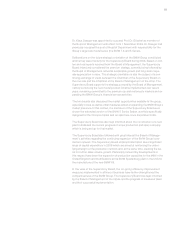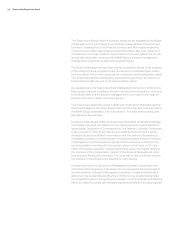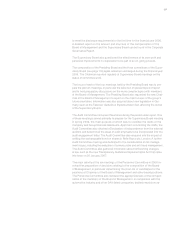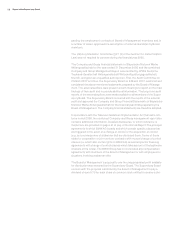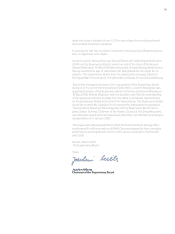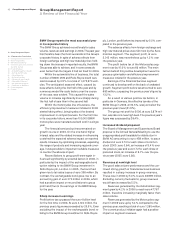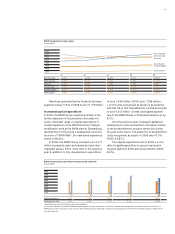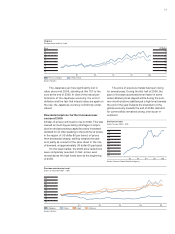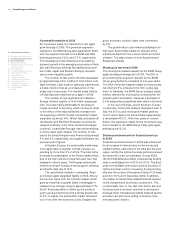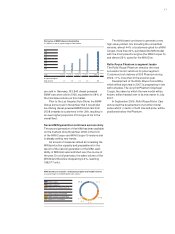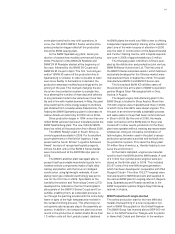BMW 2006 Annual Report Download - page 13
Download and view the complete annual report
Please find page 13 of the 2006 BMW annual report below. You can navigate through the pages in the report by either clicking on the pages listed below, or by using the keyword search tool below to find specific information within the annual report.
Business environment
Economic developments in 2006
The global economy grew strongly again in 2006.
For the most part, growth rates were even higher
than in the previous year despite the greater impact
of adverse factors. Higher interest rates worldwide
and further hikes in the price of crude oil and other
raw materials were the main reasons for higher
costs for businesses and the further reduction in
consumer buying power.
The US economy grew at a rate of 3.3% in
2006. It was initially able to maintain its role as the
motor for the global economy but, since the sum-
mer, there has been a noticeable deceleration in the
pace of growth. Amongst other factors, the sharp
rise in interest rate levels slowed down the property
boom. By contrast, the unemployment situation
had
improved by the end of the year. In general, pri-
vate consumption continued to provide momentum,
whereas investments were significantly down. Ex-
ports again failed to contribute to growth, with the
current account deficit refusing to shift from a level
of well over 6% of gross domestic product.
In the euro region, gross domestic product grew
strongly by 2.7% in 2006, performing dynamically
again for the first time in years. The main factors
contributing to this development were continuing
high investment levels and rising private consumer
expenditure. Overall, however, despite the sharp
growth in exports, the current account for the euro
region was still negative.The improved performance
tailed off slightly towards the year-end.
The German economy grew by 2.5% in 2006.
In addition to the continuing boom in investments
and exports, after a considerable absence, consumer
expenditure edged up, to a large extent brought
forward into 2006 in the light of the
value added tax
increase at the beginning of 2007. On top of that,
the construction industry was able to overcome the
crisis it has been facing ever since reunification and,
once again, make a positive contribution to growth.
The economies of new EU member states
again performed well in 2006.This was under-
pinned in all of the countries involved by very
dynamic export performances and robust domes-
tic economies.
In 2006, the Japanese economy grew at
about
2%, matching the previous year’s growth
rate and confirming the end of a long weak phase.
The sources of growth in 2006 were well-balanced,
driven by both domestic and export factors; gradu-
ally, deflationary trends also appear to have been
overcome.
The emerging Asian countries again registered
the strongest growth rates in 2006. While the Indian
economy expanded by more than 8%, the Chinese
gross domestic product again grew at a rate in ex-
cess of 10%. South-East Asian economies grew
on average by approximately 5.5%.
US dollar loses value over course of year
The US dollar again lost value against the euro over
the course of 2006. Compared to an exchange rate
of US dollar 1.18 to the euro at the beginning of the
year, the US currency slipped to a rate of over US
dollar 1.33 to the euro over the course of the year,
finishing at US dollar 1.32 to the euro and therefore
11.9% weaker than at the beginning of the year.
Although the British pound remained within its
longstanding range of GBP 0.70 and 0.67 to the
euro, it has shown signs of strengthening since the
middle of the year.
General Economic Environment
Exchange rates compared to the Euro
(Index: 31 December 2001 = 100)
170
160
150
140
130
120
110
100
90
02 03 04 05 06
US Dollar
Source: Reuters
Japanese Yen British Pound
12 Group Management Report
10 Group Management Report
10 A Review of the Financial Year
12
General EconomicEnvironment
15 Review of operations
38 BMW Stock and Bonds
41 Disclosures pursuant to §289 (4)
and §315 (4) HGB
43 Financial Analysis
43 – Internal Management System
44 – Earnings performance
46 – Financial position
48 – Net assets position
50 – Subsequent events report
50 – Value added statement
53 – Key performance figures
54 – Comments on BMW AG
58 Risk Management
62 Outlook


